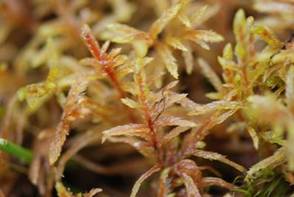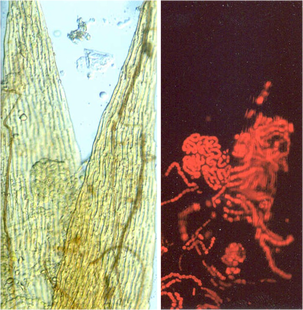Background

Fig 1. The feathermoss Pleurozium schreberi (photo T.DeLuca)
Nitrogen (N) is fundamental driver of ecosystem processes in Arctic and Boreal ecosystems of northern Europe, ecosytems which are commonly N limited. However, we have only a partial understanding of the mechanisms that control N availability and turnover in these systems. It has recently been demonstrated (DeLuca et al. 2002) that dominant feather moss species (Fig 1) within the ground layer of boreal forests harbor associative cyanobacteria (Fig 2) that fix N and thus serve as a fundamental N source, replenishing N lost from the ecosystem via various export mechanisms (e.g. fire, timber harvest, erosion).

Fig 2. Cyanobacteria (photos P. Lundgren & U. Rasmussen.)
Boreal feather mosses can account for over 90% cover of the forest floor, can provide greater annual productivity than the overstory, and are broadly distributed across Boreal and Arctic ecosystems. Over time, boreal forests accumulate large pools of organic N, greatly as a result of feathermoss N fixation, however, little of that N is available for plant uptake and few studies have addressed mechanisms of N turnover in this pool. Further, boreal carbon (C) dynamics (including photosynthesis, microbial growth, and decomposition), and greenhouse gas emissions (CO2, CH4, and N2O) are directly or indirectly dependent upon an available N resource. Importantly, no higher animals feed on feathermosses, so there is no direct trophic release of N via grazing. Feathermosses are clearly an important cog in the N cycle of boreal forests but our knowledge of the ecology of feathermoss-cyanobacterial associations and the turnover and fate of N fixed are greatly incomplete.
The image on the right shows a micrograph of a section of Pleurozium schreberi leaf at x200 magnification. Under light microscope (left) coiled chains of cyanobacteria (Nostoc spp.) are hidden in the leaf, but are readily observed as the red cells under ultraviolet-fluorescence microscopy with a green filter (right).
The image on the right shows a micrograph of a section of Pleurozium schreberi leaf at x200 magnification. Under light microscope (left) coiled chains of cyanobacteria (Nostoc spp.) are hidden in the leaf, but are readily observed as the red cells under ultraviolet-fluorescence microscopy with a green filter (right).
Key Knowledge Gaps
The Boreal N Gap project addesses the following questions to address key knowledge gaps, through the activites of three work packages:
WP1: Do feathermosses have the capacity to build N capital in the presence of increasing anthropogenic N enrichment?
WP2: How do plants and microbes access organic N in the organic matter pool associated with moss establishment and growth?
WP3: What is relationship between N fixed and soil and forest floor greenhouse gas emissions?
WP1: Do feathermosses have the capacity to build N capital in the presence of increasing anthropogenic N enrichment?
WP2: How do plants and microbes access organic N in the organic matter pool associated with moss establishment and growth?
WP3: What is relationship between N fixed and soil and forest floor greenhouse gas emissions?
